- Home
- John Norman
Kur of Gor Page 2
Kur of Gor Read online
Page 2
The utter masters of that world, which we will call Gor, are alleged to be the Sardar, an expression commonly translated as Priest-Kings, a word, we suppose, which tells us less of their nature than of the awe they inspire. Certainly it is a word suggesting power, perhaps of an unusually potent and unnatural sort, and mystery. One gathers the Priest-Kings are worshipped as gods, which flattery, if they have taken note of it, they apparently tolerate, and perhaps, for their own purposes, even indulge, and encourage. Priest-Kings, it is alleged, have mastered gravity, a force they can use for purposes as mighty as the forming, moving, and destroying of worlds, and purposes as trivial and convenient as visual and gravitational concealment, transportation, flight, work, and weaponry.
The nature of the Priest-Kings seems to be obscure. It is said by some that they are without form. This seems unlikely. Others claim they are invisible, and others, yet, that to see them is to die. Contradictions abound. It seems humans cannot get on without them. I see no reason to suppose that they are invisible. To be sure, it seems they are seldom seen, but this feature they share with many forms of life. Further, I see no reason to suppose that to see them is to die, though one might conjecture that they might be concerned to protect their privacy, with perhaps some severity. On Gor a caste exists, which we may refer to as that of the Initiates. The Initiates, in virtue of the study of mathematics, the adoption of various abstinences, such as the eschewing of beans, and a variety of spiritual exercises, and such, claim to be on intimate terms with the Priest-Kings and to be potent in their influence on them, for example interceding with them on behalf of generous clients, and such, say, calling down blessings, averting poor crops, prospering businesses, calming stormy seas, assuring success in warfare, and so on. They are also skilled in deciphering the secret messages encoded in the entrails of sacrificial beasts, prognosticating the meanings of the flights of birds, seen over one shoulder or another, interpreting the bellows and rumblings of flatulent tharlarion, and so on, all feats beyond the average layman. Their offices and efforts are invariably successful, and their predictions and prophecies are infallible, save when unforeseen factors intervene, which occurs not infrequently. My own suspicions in these matters is that the Initiates know as little of the Priest-Kings as anyone else, but they have hit upon an economic niche which may be profitably exploited. There are many ways to make a living and superstition affords a vein easily mined. It has much to commend it over honest labor. To be sure, one supposes the simpler of the Initiates take their nonsense seriously. Let us hope so. Too, doubtless they fulfill a need, if one which might seem to be something of a source of embarrassment for a putatively rational creature. Too, the average human might feel deprived, if not actually lost and lonely, if deprived of his superstitions. He is, after all, well aware of his vulnerability and the hazards of fortune. He is likely to appreciate any help he can get, or thinks he can get, or hopes he can get. And, too, who can prove that there are no secret messages lurking in the warm, bloody livers of slaughtered verr? And if the Priest-Kings choose to invest their intentions or reveal their will in the flights of birds or the emanations of discomfited tharlarion who is to gainsay them?
Human beings tend to assume that the Priest-Kings are rather like themselves, that they are human, or, at least, humanoid. Perhaps their vanity prompts such a speculation. Kurii, too, incidentally, assume that the Priest-Kings must be somehow akin to them. Surely the terror of their ships and the accuracy of their weaponry suggests that. But let us not waste fruitless speculation on this matter. Whatever may be the nature of the Priest-Kings, it is clear, as does not seem to be the case with many gods, that they exist.
The Flame Death, with which they commonly enforce their laws, if nothing else, mitigates against agnosticism in this matter.
One thing about the Priest-Kings puzzles the Kurii, and that is why this mysterious life form seldom behaves otherwise than defensively. They will react sharply if not inevitably to border crossings, but they will not pursue the rebuffed invaders; they will not seek them out, and destroy them in their lairs.
Indeed, Priest-Kings are tolerant of the presence of Kurii on Gor itself, provided they respect their technology and weapon laws.
One supposes the Priest-Kings have a different sense of civilization than, say, humans, or Kurii, who will commonly pursue and exterminate an enemy.
Perhaps the Priest-Kings recognize the Kurii as a life form, rather as the human, and, as such, as something of interest, perhaps of value, if only scientifically.
But let us proceed. Our account, after all, has little to do with Priest-Kings, whoever or whatever they might be. It has more to do with Kurii and humans.
Indeed, our story, in particular, as you may recall, has to do with the monster. It begins, in its way, on a moon of Gor, one of its three moons, and its smallest, that called the “Prison Moon."
And, interestingly, our story begins not with the monster, but with a human being.
Yes, one of those, a human being.
And a rather unusual human being, as it turned out.
Before we begin, however, as it will prove informative, we might briefly reference the common Kur attitude toward the human, other than understanding it as an inferior life form. In some steel worlds humans are kept rather as cattle, fattened, crowded, and used for feed. Kurii are fond of meat, particularly freshly killed meat. Some Kurii however keep humans as pets, and even grow fond of them. Certain other humans, selected humans, are raised to be work animals, or prey animals. The human makes an excellent prey animal, from the Kur point of view, as it can be bred for agility, elusiveness, and cunning. It can also be dangerous, and thus, consequently, is the sport of the hunt improved.
But now to the “Prison Moon,” where our story has its beginning.
Chapter, the First:
THE TALE BEGINS
The Containment Device
He thrust violently against the close, curving, transparent walls, howling with rage.
We can understand such emotions.
They are not strange to us.
In his own language his name was said to be Tarl Cabot.
Such things do not really much matter, with such creatures. Nonetheless, to themselves, and to some of their kind, they seem of much importance. I do not know, of course, whether it was important to him, or not. Perhaps some microorganisms arrange their cilia in some bizarre fashion, and then understand themselves as being somehow thereby exalted. Are names so important? Perhaps. But is that which is named not more important? One does not know with such creatures. I think they are strange.
They cannot tell themselves from their names, nor do they care to do so. They name themselves, and things, and think thereby to acquire them. They do not do so.
They have names; reality does not.
How is it, in any event, that they so invest themselves with such importance? What a piteously naive arrogance is therein displayed.
Are they truly so unaware of their small place in the yard of existence, so ignorant of the length of space and the breadth of time, of the flight of galaxies, of the journeys of streaming light, perhaps touching nothing for a hundred thousand years; are they unaware even of the patience of stone, cogitating its memories of a molten youth? It is hard to accept that they are the offspring of stars, a freshened reconfiguration of antique components long ago expelled into the darkness, but are we not all such?
They are so tiny, and so generally useless, an active rash on quietude, a small noise, perhaps brave in its way, in the night.
But are we not, in our way, as well?
When the Nameless One stirred the cauldron of stars did it intend them? Are they not a lapse of sorts? Might it have been distracted at the time? But in what workshop or cauldron was formed the Nameless One itself? From what unseen seas was it itself cast forth, beached on shores burnt by drifting, incandescent tides, and from whence came these, the tides, the continents, these, too, children of the mystery?
Before the Namel
ess One, you see, is the Mystery.
It is that which was, and that which is, and that which will be. And none have lifted its veil.
I suppose it is offensive to conceive that we are brothers to that woeful life form, the human, one so disgusting and treacherous in its diverse paths, one so despicable in its intolerable vanity. How absurd, how repulsive, one supposes, that we are siblings in virtue of the parentage of stars.
But then we may console ourselves that we are siblings, too, to the diatom, to the smallest living thing, to the worm in the sea, the mote in the air.
But how small, how trivial, is the human.
How easily might he be struck by some astral debris, not noticing him. Or fall prey to a prolific, invasive mite, a thousand mutations from an eye or claw, a mite not even visible to his eye.
And how despicable, how contemptible, is the human!
A spawn of greed, an embracer of comfort, a seeker of ease, a blemish on the world, a wart of vanity, a stranger to honor.
One who guards his mind, fearing it will awaken.
One who guards his mind, as one might guard a prisoner.
One who so treasures his mind that he dares not use it.
His bulwark is stupidity.
And what labor is not expended in its preservation!
How mighty is the sweet shield of ignorance!
How fearfully and carefully he burnishes it!
He is a herd animal. He is unworthy of the stars.
Yet there is in that life form a spark of awareness, for all its frivolity and frailty, for all its egregious contumely and its hideous ineptitude, a flicker of mind, however reluctant, in a largely oblivious, somnolent world. It is one of the rare places the universe has stirred, and awakened, and opened its eye, and looked upon itself, startled to learn that it exists.
Does it recoil, seeing itself in the human?
Surely it rejoices, seeing itself in us, we who are worthy of it.
It is conscious in countless minds, of course, in that of the mouse, and cat, in that of the urt and verr, in that of the barracuda, in that of the viper and leopard, in that of the hith and larl.
But we are most worthy of it.
In us is its nature most fully manifested. Are we not the outward form of its inward horror, or essence? Are we not the choice fruits of its inward terrors, the splendid robes of its dark, shrieking soul? In us, it finds its fangs, and talons, its hunger, its indifference, its terribleness, its sublimity, its rage, its glory.
And it is through our eyes that it sees the stars.
One day, perhaps, the human will disband his herds and be free. One day, perhaps even the human will lift his head, and see the stars.
They are there.
I am personally, you see, not ill disposed to the human.
If I were I should not tell this story, which deals primarily with some humans, and something not human, with the monster.
And, of course, with the Kurii.
I wonder if you know of them.
They know of you.
You could not understand our name for the human with whom we will begin. In fact, you would not even know it was uttered. One might use our name for the human, of course, but you could not pronounce it. For example, if a leopard or a lion, or a larl or a sleen, had a name for you you would doubtless not recognize it as a name, let alone as your name. We will, accordingly, refer to that individual with whom we shall begin by that name by which other humans might know him, namely, as Tarl Cabot, or, as some will have it, Bosk, of Port Kar.
He pounded again, and again, at the transparent walls, until his hands bled.
Bruised, and bewildered, he sank down then, naked, inside the bottlelike container. Such containers taper toward the bottom, that wastes may drain from them. They taper, too, toward the top. Near the top a tube descends periodically, automatically, through which liquid, if the occupant chooses to live, may be drawn by the mouth into his body. The entire facility is automated, though one supposes some supervisory personnel may be in attendance, if only by means of olfactory devices, listening devices, cameras, or such. Certainly one seldom sees them. The tube's descent is indicated by an odor. The corridors are commonly empty and silent. One may conjecture, occasionally, from the outside, that within the containers there is sound, this being surmised from the expressions of the occupant, the motions and configurations of his mouth, the gestures of his limbs, such things. The container is rather oval, or ovoid, rounded, ascending rather vertically, but narrowing, rounded, toward the top and bottom. The diameter, in measurements likely to be familiar to the reader, would be something like four feet, whereas the container, as a whole, is something like eight feet in height, though much of this space is not conveniently utilizable, given the tapering at the top and bottom. In such a container one sleeps as one can. Indeed a soporific gas may be entered into the container remotely, which suggests there is some actual surveillance of the containers. Too, the air in the container may be drawn from the container, should one wish, say, to terminate an occupant, clear the space for a new occupant, and so on. Too, it might be noted that the corridor itself, as most of the structure, is airless. This contributes to the incarcerational efficiency of the facility.
Various life forms may be kept in such containers.
From where he was contained, the human in question, Tarl Cabot, could see several tiers of similar containers, several of them occupied. He did not realize at the time the absence of air outside the container, as the container itself contained a regulated, breathable atmosphere. And probably some of the other life forms did not understand that either. One supposes, incidentally, that there were diversities in the container atmospheres, as, upon inspection, there appeared to be substantial dissimilarities amongst their occupants.
In the human species, aside from some unusual specimens, there are two sexes. Commonly both collaborate in replication. Interestingly, the biological functions of conception, gestation, and nurturance in the human species are all centered in a single sex, that of the female. Among the Kurii, on the other hand, the procedures of replication are conveniently divided amongst three, or, if you like, four sexes. There is the dominant, the submissive, and the nurturant, who gestates and nurtures, until the child is mature enough to chew and claw its way free. At that point it is ready for meat. It is not clear if the nurturant was a naturally evolved entity or if it was the result of biological engineering long ago, in the Kurii's original world, or one of its worlds, for it may have destroyed more than one. Indeed, the technology of the nurturant might have been obtained from another species. It is not known. These thing are lost in the prehistory of a species, so to speak, or at least in the time from which no histories remain. The fourth sex, if one may so speak, is the nondominant. Under certain unusual circumstances the nondominant becomes a dominant. It is very dangerous at such times, even to dominants.
The individual, Tarl Cabot, doubtless called out a number of times, angrily, requesting an explanation or justification for the predicament in which he had so unexpectedly found himself. That would be only natural. From outside the container, of course, given the container and the near vacuum of the corridor, he could not be heard, nor, it seemed, was there anyone there to listen. He may not have recognized this, or, if he suspected it, he might have supposed that somehow sounds from within the container might be conveyed, doubtless by means of some listening device, to some point at which they might be audited, or recorded, for future audition. On the other hand, given the emptiness of the corridor, and the absence of intelligible communication from an outside source, he had no assurance that his demands, protests, or such, were anywhere registered, or even that they might be of the least interest to anyone or anything.
Needless to say this can be unsettling.
Indeed, it can derange certain sorts of minds. The instincts of many caged animals, on the other hand, are more healthy. Understanding themselves trapped, they are patient, and wait. Beyond a certain interval they do not exhau
st their resources, but conserve them, almost lethargically, for a given moment, for the sudden movement, for the lunge, the movement to the throat. So, after a time, Tarl Cabot, who was not particularly disanalogous to such beasts, became quiescent, at least as far as external observation might detect. This was in conformance, incidentally, with certain recommendations of his caste codes. One can learn much, even from the codes of humans. He was, as we learned, of what on Gor amongst humans is referred to as the scarlet caste. This is a high caste, doubtless because it is armed. Individuals of this caste are of great value to their cities, their employers, their princes, so to speak. Indeed, they are indispensable in their way; have they not, however unintentionally, secured the foundation of law; have they not, however unbeknownst to themselves, raised from the mire of brutishness, insecurity, and terror the towers of civilization? Surely it is they who must man the walls and defend the bridges, who must police the streets and guard the roads, and who will in sunlight, or in darkness and storms, carry forth the standards. They are unusual men and seldom understand their own nature, nor need they. Perhaps it is better that they do not. Let them laugh and fight, and drink and quarrel, and seek their slaves in conquered cities and taverns, and chain them and put them to their feet, and not inquire into the dark and mighty processes which have bred them, which have made them so real, and necessary. And so they are encouraged to emulate the stealth and savagery of the larl, the cunning and tenacity of the sleen, the vigilance and swiftness, the alertness, of the mighty tarn. They are companions to discipline; they are hardened to short rations, long watches, and the march; they are inured to the exigencies of camp and field; and trained to fight, and kill, preferably swiftly and cleanly. They do not know how they came to be, but they would not be other than they are. They are more beast than man, and more man than beast. They are, so to speak, dangerous beasts with minds. And such have their utilities. We may laud them or despise them. They are called Warriors.

 Avengers of Gor
Avengers of Gor Kajira of Gor coc-19
Kajira of Gor coc-19 Mercenaries of Gor coc-21
Mercenaries of Gor coc-21 Witness of Gor coc-26
Witness of Gor coc-26 Witness of Gor
Witness of Gor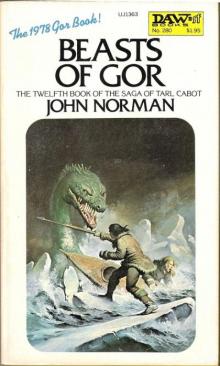 Beasts of Gor coc-12
Beasts of Gor coc-12 Rebels of Gor
Rebels of Gor Mariners of Gor cog[oc-30
Mariners of Gor cog[oc-30 The King th-3
The King th-3 Captive of Gor coc-7
Captive of Gor coc-7 The Captain th-2
The Captain th-2 Vagabonds of Gor coc-24
Vagabonds of Gor coc-24 Explorers of Gor
Explorers of Gor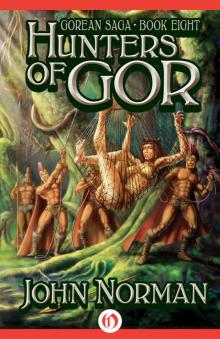 Hunters of Gor
Hunters of Gor The Chieftan th-1
The Chieftan th-1 Outlaw of Gor
Outlaw of Gor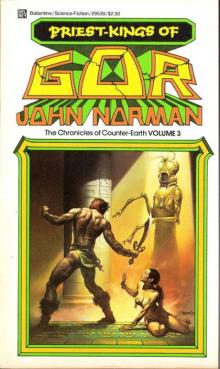 Priest-Kings of Gor coc-3
Priest-Kings of Gor coc-3 Norman Invasions
Norman Invasions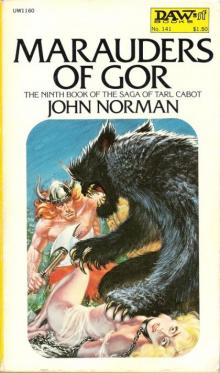 Marauders of Gor coc-9
Marauders of Gor coc-9 Kur of Gor coc-28
Kur of Gor coc-28 Time Slave
Time Slave The Chieftain
The Chieftain Kur of Gor
Kur of Gor Rogue of Gor
Rogue of Gor The Totems of Abydos
The Totems of Abydos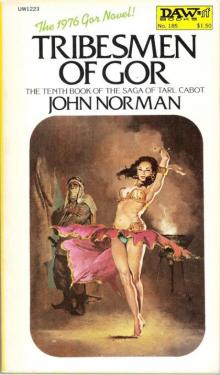 Tribesmen of Gor coc-10
Tribesmen of Gor coc-10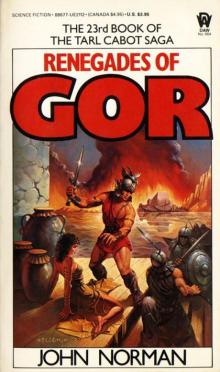 Renegades of Gor coc-23
Renegades of Gor coc-23 The King
The King Tarnsman of Gor
Tarnsman of Gor The Usurper
The Usurper Captive of Gor
Captive of Gor Conspirators of Gor
Conspirators of Gor Smugglers of Gor
Smugglers of Gor Savages of Gor
Savages of Gor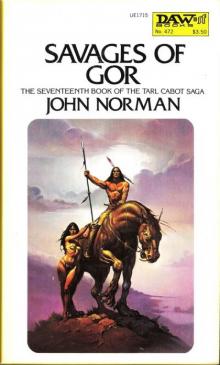 Savages of Gor coc-17
Savages of Gor coc-17 Fighting Slave of Gor
Fighting Slave of Gor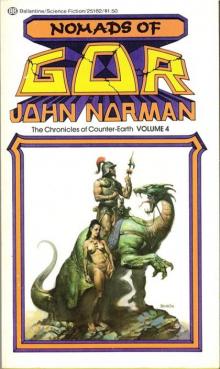 Nomads of Gor coc-4
Nomads of Gor coc-4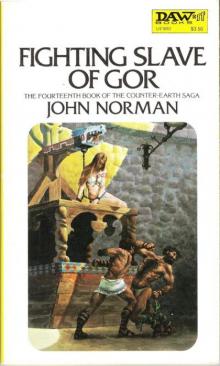 Fighting Slave of Gor coc-14
Fighting Slave of Gor coc-14 Swordsmen of Gor cog[oc-29
Swordsmen of Gor cog[oc-29 Priest-Kings of Gor
Priest-Kings of Gor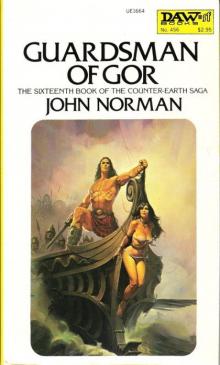 Guardsman of Gor coc-16
Guardsman of Gor coc-16 Hunters of Gor coc-8
Hunters of Gor coc-8 Dancer of Gor coc-22
Dancer of Gor coc-22 Prize of Gor coc-27
Prize of Gor coc-27 Conspirators of Gor cog[oc-31
Conspirators of Gor cog[oc-31 Slave Girl of Gor
Slave Girl of Gor Explorers of Gor coc-13
Explorers of Gor coc-13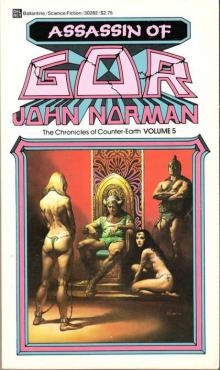 Assassin of Gor coc-5
Assassin of Gor coc-5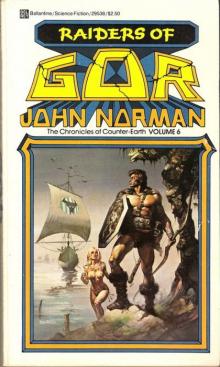 Raiders of Gor coc-6
Raiders of Gor coc-6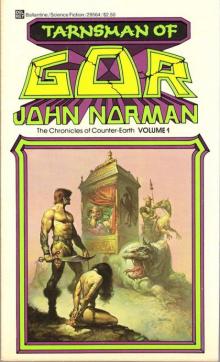 Tarnsman of Gor coc-1
Tarnsman of Gor coc-1 Dancer of Gor
Dancer of Gor Outlaw of Gor coc-2
Outlaw of Gor coc-2 Guardsman of Gor
Guardsman of Gor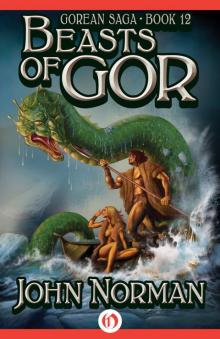 Beasts of Gor
Beasts of Gor Ghost Dance
Ghost Dance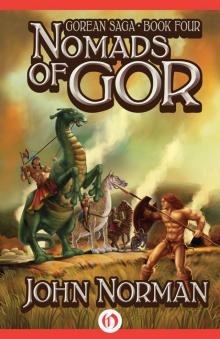 Nomads of Gor
Nomads of Gor Prize of Gor
Prize of Gor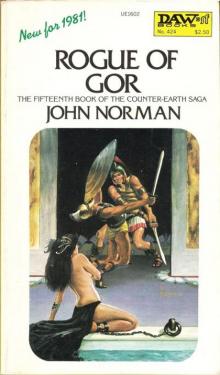 Rogue of Gor coc-15
Rogue of Gor coc-15 Swordsmen of Gor
Swordsmen of Gor